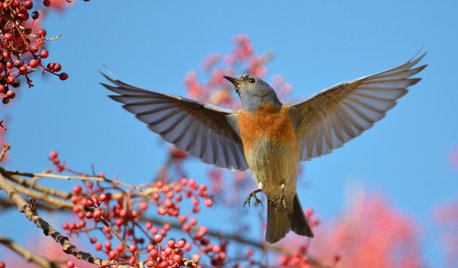Home made Caterpillar food for Cercropias?
curiositykat
12 years ago
Related Stories

GARDENING GUIDESHow to Bring the Joy of Bluebirds to Your Garden
Attract these beautiful songbirds with nesting habitat and food sources, including berry-producing trees and shrubs
Full Story
GARDENING GUIDESThese Hummingbird-Attracting Native Plants May Surprise You
These flowers, vines and shrubs offer shelter and food supplies that keep hummingbirds around longer
Full Story
DECLUTTERINGDecorate with Intention: Clutter Clearing 101
Fearlessly face disorganized areas to find the home of your dreams
Full Story
LOFTSHouzz Tour: A Commercial Laundry Gets Recycled Into a Dramatic Home
See how this 1923 behemoth becomes the ultimate home for entertaining and more
Full Story
GARDENING AND LANDSCAPINGWorld of Design: 10 Home Gardeners Show Us Their Sweet Summer Harvests
From New York to Tokyo, these gardeners have turned their yards, terraces and rooftops into places of bounty
Full Story
ARTHouzz Call: Show Us Your (Functional?) Art
We want to see how art plays a part in your home
Full Story
KITCHEN DESIGNKitchen of the Week: Elegant Updates for a Serious Cook
High-end appliances and finishes, and a more open layout, give a home chef in California everything she needs
Full Story
GREEN BUILDINGWhat's LEED All About, Anyway?
If you're looking for a sustainable, energy-efficient home, look into LEED certification. Learn about the program and its rating system here
Full Story
GARDENING FOR BUTTERFLIESBring on the Birds: Natural Habitat Ideas for Gardens of All Sizes
Provide nesting, watering and perching spots inspired by the Costa Rican jungle and watch the birds flock on over
Full Story
INSPIRING GARDENSFrom Concrete Lot to Gracious Organic Garden in Seattle
Plants, pests and even weeds have a place in this landscape, which offers an edible bounty and a feast for the eyes
Full Story






KC Clark - Zone 2012-6a OH
KC Clark - Zone 2012-6a OH
Related Professionals
Frisco Landscape Contractors · Ashburn Landscape Contractors · Brockton Landscape Contractors · Dallas Landscape Contractors · North Chicago Landscape Contractors · Suitland Landscape Contractors · Jacksonville Fence Contractors · Antelope Fence Contractors · Crowley Fence Contractors · Leesburg Fence Contractors · Skokie Fence Contractors · Savage Fence Contractors · Duarte Fence Contractors · Washington Window Contractors · Yeadon Window ContractorsKC Clark - Zone 2012-6a OH
larry_gene
curiositykatOriginal Author